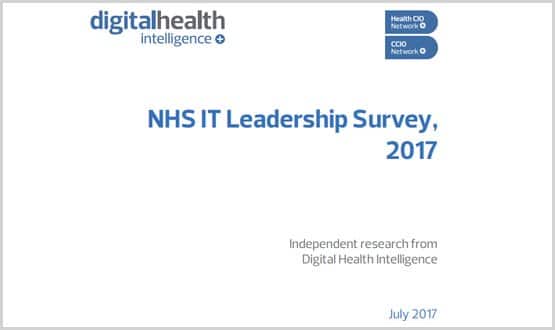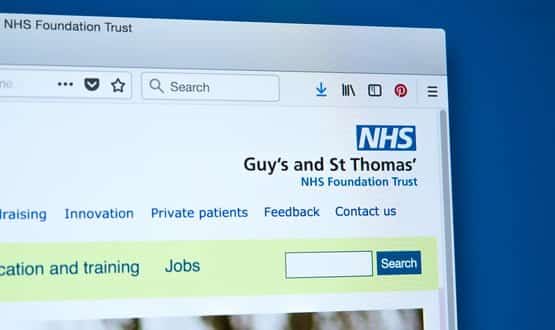Confidence in achieving NHS 2020 digitisation targets falls

Digital Health Intelligence’s annual survey of NHS IT leaders has found levels of confidence on achieving national targets on achieving a paperless health service and delivering integrated digital health and care records by 2020 have dropped over the past 12 months.
Uncertainty and delays over promised future national funding for NHS digitisation were cited as the main reasons.
Cyber security is the area that has risen sharply in the priorities of NHS IT leaders in the last 12-months. In 2016, cyber security was a priority for just 23% of NHS IT leaders. But in the 2017 survey, which was carried out before the 12 May Wannacry incident that hit many NHS organisations, it was identified as a priority by 66%.
The 2017 survey results also highlighted key concerns about IT in the strategic and investment agenda shift towards Sustainability and Transformation Plans, Local Digital Roadmaps and the emergence of the Global Digital Exemplar programme, through which the NHS is now prioritising national IT investment in a small number of reference sites and hoping these will provide ‘blueprints’ for others to follow.
Almost two-thirds (63%) of NHS IT leaders said they were uncertain whether the GDE programme would benefit the whole health system.
Tara Athanasiou, director of Intelligence at Digital Health said: “The results of the 2017 NHS IT leadership survey show there is a growing reality of digital haves and have nots, with the dividing lines increasingly clear after the launch of the Global Digital Exemplar programme.
“The uncertainty over future sources of national funding is an overriding theme from the 2017 survey. The next 12-months will be crucial, as the GDE and associated Fast Follower programmes funding kicks in and the impact across wider health economies can start to be measured.”
Within this context of uncertainty, the 2017 survey found that confidence in meeting 2020 targets for paper-light working and integrated digital care records (IDCR) between health and social care have fallen sharply in the last 12-months.
Just over half (56%) of NHS IT leaders are now confident in meeting the 2020 paper-light target. This has dropped from 69% being confident of meeting the target in 2016. There has also been an 11% drop in confidence in meeting the 2020 IDCR target in the last 12-months, falling from 51% in 2016 to just 39% in 2017.
More positively, genomics and artificial intelligence were identified by NHS IT leaders as offering the greatest potential to benefit future healthcare.
The annual NHS IT Leadership Survey conducted by Digital Health Intelligence enables year-on-year comparisons and changes to be identified in the sentiment, priorities, and concerns of NHS IT leaders.
IT infrastructure was identified as the main IT project by 63% of NHS IT leaders. The spotlight on the ageing infrastructure of some NHS organisations, highlighted after the 12 May WannaCry attack, underlines the importance of a robust and resilient IT infrastructure.
Whilst it will lay the foundation for future advanced technology projects, such as genomics and artificial intelligence, the current focus on infrastructure is likely to push out the timescales for more complex initiatives.
Patient health records were identified as the next major IT project for the second year running, cited by 40% of NHS IT leaders in 2017. However, the adoption of patient digital services has been slow over the last 12-months, with little change since 2016.
The NHS IT Leadership Survey 2017 is the second annual survey of the members of the CCIO and Health CIO networks, and broader health IT leadership community, carried out by Digital Health Intelligence.
The 2017 survey had 152 responses from NHS IT leaders from acute, mental health and community trusts, primary care organisations, clinical commissioning groups, commissioning support units, together with NHS organisations in Scotland, Wales and Northern Ireland.
Full copies of the survey report are available to subscribers to Digital Health Intelligence and NHS IT leaders who completed the survey.





8 Comments
I just wondered with regards to the whole digitisation project what happens to the health records staff during the process were they simply absorbed into individual trusts i.e. Redeployment or were there staff cuts i.e. Redundancies?
…from EDM btw not EPR…
Thanks Geoffrey, that makes sense. Bw.
i can substantiate the £300m figure from empirical evidence of deployment and further business case work I have done in 10 Trusts – space, pay and consumables do it. 200,000 sq m of space and 10,000 WTE of freed up staff…0.5% of turnover for each Trust on a recurring basis…
I’m interested in Geoffrey Brooke’s comment …. £300m savings across England if all Trusts implemented an EPR. Is the detail of this documented somewhere? Some Trusts have already made significant savings on the back of, for example, document and pharmacy management systems.
I’m interested in Geoffrey Brooke’s comment …. £300m savings across England if all Trusts implemented an EPR. Is the detail of this documented somewhere? Some Trusts have already made significant savings on the back of, for example, document and pharmacy management systems.
There are still some who believe EPRs alone will deliver this, the average acute Trust is generating 50,000 pieces of paper a week – if we don’t deal with the legacy (usually with some form of Document Management solution) then we have no chance. Funding is an issue as most Trusts do not have a strong enough balance sheet to sustain the investment needed unaided. If every acute Trust in England did this it would save £300m per annum in space, pay and consumables…
With regard to the GDE programme, I offer the following quote from Sean Brennan referring to ERDIP:
The problem [of ERDIP] was the strategic significance of funding over 20 different projects which did not move the agenda forward proportionate to their efforts. In fact, their results may have caused more strategic confusion than clarification.
(Sean Brennan: The NHS IT Project; 2005)
Let’s hope those involved in GDE have read Mr Brennan’s work.
Comments are closed.